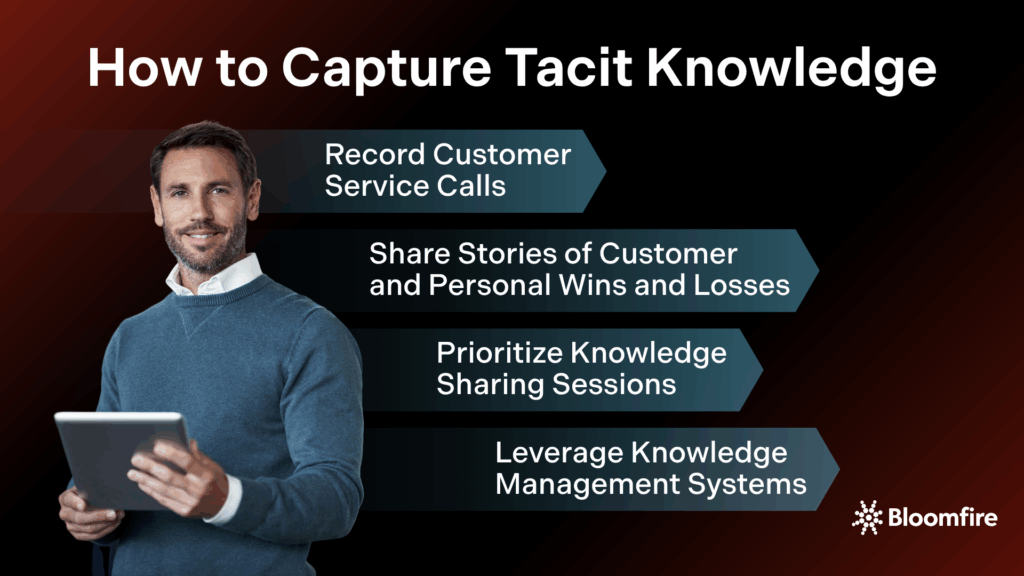How to Capture and Share Tacit Knowledge

In today’s business world, capturing, retaining, and sharing knowledge is more important than ever if your company wants to stay ahead of the curve. If an employee only knows how to do their job strictly from their training materials, what happens when they face a complex problem requiring knowledge beyond their training?
If employees were able to access and share tacit knowledge –knowledge gained through personal experience and context–complex problems would have solutions, leading your company ahead of the competition while increasing productivity and creating a healthier workplace culture.
Documenting tacit knowledge is difficult to accomplish because this type of knowledge is deeply rooted in personal experience and context, being unspoken and instinctive information that can’t necessarily be written down. Fortunately, implementing a knowledge management system like Bloomfire makes it possible to capture tacit knowledge and propel your company towards Enterprise Intelligence.
What is Tacit Knowledge?
Tacit knowledge lives in your employees’ minds, stemming from years of personal and professional experiences, intuitions, and insights. This knowledge is not typically straightforward to articulate, making it challenging for organizations to extract and document, even when individuals are willing to share.
In Bloomfire’s Value Report, 73% of employees say they frequently rely on coworker knowledge that isn’t documented anywhere. Yet fewer than 1 in 4 companies have a system for capturing that insight. Why is it hard to document? Compared to explicit knowledge—such as training materials or other documents—people often use tacit knowledge instinctively rather than relying on documented knowledge provided to them.
Tacit knowledge is acquired through observation, practice, trial and error, and socialization, rather than formal instruction and documentation. Therefore, it is incredibly challenging to document someone’s instincts and personal experiences, because that information simply cannot be put on paper.
Examples of Tacit Knowledge
To better understand and define tacit knowledge, here are some examples of employees applying tacit knowledge in their workflow:
- Long-time sales representatives might instinctively know the right approach and timing to pitch a product to customers. This skill is difficult to teach but is gained directly from experience.
- Experienced employees might know a quicker, more efficient way to complete a task beyond what current training materials describe, learned through hands-on experience.
- A software developer can quickly debug code based on pattern recognition developed over years of experience, something that isn’t easily described for others.
These examples illustrate how tacit knowledge is deeply rooted in personal experience and practical expertise, making it a valuable but often invisible asset in organizations. Capturing and sharing this knowledge is essential for sustaining organizational performance and innovation.
How to Capture Tacit Knowledge
Tacit Knowledge is hard to document, so teams must facilitate human interaction and knowledge sharing to make implicit knowledge explicit and accessible. Fortunately, companies can capture this and turn vital tacit knowledge into valuable insights for other employees.

Record Customer Service Calls
Recording customer service calls and uploading them to a knowledge management platform can expose your less experienced employees to a range of customer service scenarios and introduce them to strategies for addressing them.
They’ll get to hear how experienced customer service reps handle complex issues or address stressed-out customers, and see examples of employees thinking on their feet and adjusting their strategy when a call takes an unexpected turn. Employees can also hear tone and inflection—things that are nearly impossible to document in a traditional training manual.
Share Stories of Customer and Personal Wins and Losses
Marketing professionals know that case studies have power because potential customers want to see how a company’s product or service worked for someone else before they try it themselves. The same idea can work for capturing tacit knowledge.
Encourage experienced employees to document stories of customer and personal wins.. Ask them to detail the strategies they used, how customers reacted, and what did or did not work. By making these stories available on something like a knowledge-sharing platform, other team members can learn new tactics to use (or avoid).
Over years of working at your company, employees cultivate a wealth of knowledge that can’t always be documented in traditional materials. By capturing this tacit knowledge, you can ensure all your employees have the opportunity to benefit from that experience and insight—and use it to better serve your customers.
Prioritize Knowledge Sharing Sessions
When employees spend time in knowledge sharing sessions with other team members, they create structured opportunities for employees to share their personal experiences, insights, and problem-solving approaches. By recording knowledge sharing sessions, employees can capture relevant tacit knowledge and access the recordings for future use.
Implement structured interviews, storytelling sessions, and after-action reviews to capture unspoken knowledge and lessons learned. Storytelling is especially powerful for sharing complex and nuanced tacit knowledge in a memorable way because listeners can identify which tacit knowledge works well for them and why.
Leverage Knowledge Management Systems
Knowledge management systems provide a centralized digital platform where employees can document, share, and access experiential insights and best practices, including tacit knowledge. They enable the capture of tacit knowledge through mechanisms such as recorded storytelling, video tutorials, annotated process guides, and forums where experts share detailed advice.
With a knowledge management platform like Bloomfire, companies can facilitate the externalization process of tacit knowledge by offering tools for collaborative content creation and knowledge exchange. They also archive and organize this knowledge, making it easily searchable and accessible for ongoing learning and decision-making.
Advantages of Capturing and Utilizing Tacit Knowledge

Why is tacit knowledge important? Well, companies that identify, capture, and utilize tacit knowledge will see monumental benefits in their day-to-day workflows. Here are some of the benefits of using tacit knowledge as an asset:
- Preserve valuable company knowledge by converting individual expertise into shareable formats, preventing any knowledge loss when employees leave.
- Foster a collaborative workplace culture that breaks down barriers to knowledge sharing and encourages collective learning.
- Accelerate onboarding and skill development by providing new hires with practical insights and problem-solving shortcuts from experienced coworkers.
- Boost productivity and efficiency by making expert strategies and solutions accessible, reducing the need to consult senior staff for routine or complex issues.
- Improve decision-making with quicker and easier access to critical insights and tacit understanding across teams.
- Drive innovation and creativity by leveraging employees’ deep knowledge and intuition to explore new ideas and solutions, providing a competitive advantage by equipping employees with expertise that differentiates the company in the marketplace.
These are just some of the many benefits of companies applying tacit knowledge to their daily workflows. Capturing these valuable insights transforms implicit, personal knowledge into organizational assets that enhance performance, empower employees, and support continuous improvement.
Capture and Share Tacit Knowledge to Achieve Enterprise Intelligence
Capturing and sharing tacit knowledge is a crucial part of achieving Enterprise Intelligence, going beyond simply storing information by unifying all structured and unstructured knowledge, including tacit insights, into a connected and adaptive intelligence layer. This delivers real-time, actionable knowledge directly into workflows where decisions are made, leading to faster, smarter decisions, increased alignment, and more productive collaboration.
Using knowledge management systems like Bloomfire provides tools to capture, codify, and make tacit knowledge accessible throughout the organization, preventing information silos and knowledge loss during turnover. With Bloomfire, capturing and sharing tacit knowledge unlocks hidden organizational intelligence, creates an engaged, sharing culture, improves decision-making speed and accuracy, and drives measurable business outcomes.
Frequently Asked Questions
How can organizations foster a culture that encourages the sharing of tacit knowledge?
Organizations can foster a culture of knowledge sharing by prioritizing trust, collaboration, and psychological safety. When employees feel valued and safe to share experiences, they are more likely to exchange insights that might otherwise remain unspoken. Encouraging cross-functional teamwork, informal discussions, and mentorship programs helps break down silos that isolate valuable expertise.
How can organizations ensure that tacit knowledge remains accessible and usable over time?
To preserve tacit knowledge, organizations need to convert it into accessible, usable formats without losing its context by capturing it through structured interviews, recorded demonstrations, and discussion documentation. Maintaining central repositories, like knowledge management platforms, ensures that insights remain available even after employees depart. By institutionalizing both tacit knowledge capture and refresh cycles, companies sustain a living, evolving knowledge base.
What structured approaches can teams take toward documenting tacit knowledge for training and succession planning?
Teams can use methods like knowledge mapping, process walkthroughs, and after-action reviews to document tacit knowledge effectively. These approaches identify critical expertise, align it with key roles, and translate it into formats suitable for onboarding or training. Integrating this documentation into training modules or digital knowledge hubs ensures consistency and accessibility across teams.
What role do leadership and mentorship play in transferring tacit knowledge?
Effective leaders actively encourage open dialogue, reflection, and feedback, creating environments where experience-based learning thrives. Mentors bridge generational or experiential gaps, guiding less experienced employees through real-life scenarios that formal training cannot replicate. When leaders value and practice knowledge sharing, it cascades throughout the organization, embedding continuous learning into the company’s DNA.
Applying Tacit Knowledge to Drive Innovation and Success
Tacit knowledge tends to be overlooked by organizations because this knowledge is rarely documented or shared, along with being difficult to capture in the first place. However, teams that can capture and leverage their employees’ tacit knowledge will see direct gains in productivity, accuracy, and efficiency, ultimately pushing your company ahead of competitors that do not.
The easiest and most secure way to capture tacit knowledge is to implement a knowledge management platform like Bloomfire. Teams can stop relying on tribal knowledge and start activating the unspoken expertise that drives daily decisions. Capturing tacit knowledge is one of the first steps in achieving Enterprise Intelligence, and Bloomfire can help your company get there.
By capturing and sharing tacit knowledge, your company unlocks the collective expertise and insights of its employees, preserving valuable knowledge for future generations, and fosters a culture of open collaboration and continuous learning. Capturing tacit knowledge also fuels innovation, increases adaptability in changing environments, and gives your business a competitive advantage by ensuring critical knowledge is accessible, not lost when staff leave or roles change.
This post was originally published in August 2019 and was recently updated in October 2025.
Capture Tacit Knowledge
Learn more about how Bloomfire can help your organization capture and share knowledge.
Learn More!

Enterprise AI Search: Definition, Benefits, and Evolution

The Benefit of Company-Wide Knowledge Management in 2026

Are You Making These Common Knowledge Sharing Mistakes?

Estimate the Value of Your Knowledge Assets
Use this calculator to see how enterprise intelligence can impact your bottom line. Choose areas of focus, and see tailored calculations that will give you a tangible ROI.

Take a self guided Tour
See Bloomfire in action across several potential configurations. Imagine the potential of your team when they stop searching and start finding critical knowledge.
